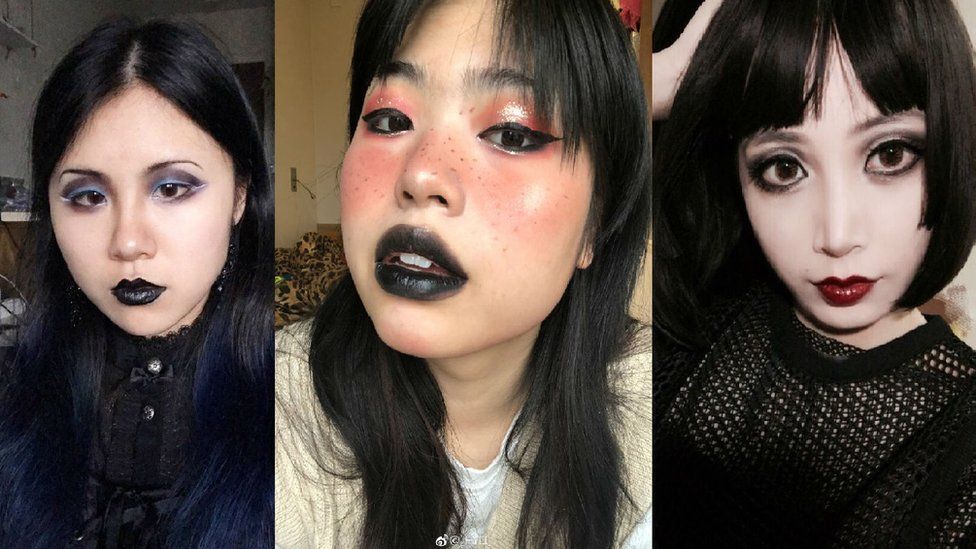Chinese goths post selfies in protest after subway incident
- Published

China's community of goths is coming together in protest online after a woman was made to remove her make-up before being allowed to enter a busy subway.
The woman, who media are not naming, posted on social media that she was stopped by subway security in the southern city of Guangzhou, and told that she needed to remove her dark make-up if she wanted to travel.
Although she was not carrying any prohibited items, she was told she would be refused entry unless she removed her make-up, to avoid "distressing" other passengers.
Since similar incidents have come to light, Weibo users have begun using the hashtag #ASelfieForTheGuangzhouMetro and sharing pictures of themselves in gothic make-up and attire.
Although subway staff have officially apologised, China's netizens are saying that it is their freedom to dress however they want, and are calling for wider acceptance of subversive styles.
What happened?
On 10 March, a woman wearing dark lipstick and heavy eye make-up was stopped at the security check point of a subway station.
She described the experience on her Sina Weibo microblog. "A female security guard called her manager, and said that my make-up was 'problematic and really horrible'." She adds that she was asked to "please remove it".
"I'm hoping to use this relatively public platform to challenge the authorities: what laws grant you the right to stop me and waste my time?" she asked.
The Guangzhou subway has since apologised and says that it had carried out an investigation and found that staff handled the situation inappropriately.
It says it has suspended a member of staff linked to the incident and adds that she will receive remedial training when she returns to work.
#ASelfieForTheGuangzhouMetro
The unnamed woman's post has been shared more than 5,000 times, and media website NetEase brought to light at least two previous incidents on the same subway from 2018.
The revelation has enraged Weibo users, and has led to thousands posting pictures of themselves in solidarity.
Some 5,000 Weibo users have used the hashtag #ASelfieForTheGuangzhouMetro, and many are criticising subway staff for ordering the woman to change the way she was dressed.
Many shared pictures of themselves out in public and say that they will not be made to feel invisible.
"I'm on the bus; please hand me the makeup remover," mocks He Jianlu.
"I've had too many scary experiences on the subway, but I've never made a child feel afraid," says Chunmeng Dingzhi.
Many say that it is their own right to choose what they wear.
"If beauty ideals remain the same, then art will die out," adds Sansen Chenww. "I'm not a murderer, an arsonist, I don't smoke or spit in public, I just love gothic dress."
"It's 2019, girls have the right to decide their own hairstyle and makeup, they do not need to seek the approval of strangers," says Qin-2Y.
"What you see as fancy dress, I see as freedom," adds Jiolaa.
How did gothic culture enter China?
Gothic culture has entered the mainland largely as a Japanese import, as a result of the growing popularity of "Lolita fashion" - a style of clothing with Victorian and Edwardian influences.
E-commerce websites have seen a boom of suppliers offering the flamboyant style of dress, and while it has found popularity as a form of costume play or "cosplay", it has also seen uptake as a choice of day-to-day wear.
Japanese manga novels, and the Twilight novel franchise have also been influential in bringing gothic culture to China. While many books with dark themes are banned for being too violent or pornographic, some are seen by Chinese youths as treading the fine line of being acceptable, yet slightly subversive.
Emo a no-no
Music associated with western gothic culture has seen limited, but growing success in China.
American band Linkin Park and Canadian singer Avril Lavigne found fame in the late 2000s, and an increased number of bars and nightclubs in major cities cater to gothic themes.
Rock music, however, as a whole is largely frowned upon in the country, and few acts enjoy much success.
China is wary of subcultures that might be seen to have an adverse effect on young children, especially if they have alleged overseas influences. It has already taken steps to ban elements of hip-hop culture, with broadcasters blurring tattoos and earrings if they are worn by male performers.
But with Chinese millennials having more spending power and opportunities to travel, there is the likelihood of broader exposure to gothic culture.
BBC Monitoring reports and analyses news from TV, radio, web and print media around the world. You can follow BBC Monitoring on Twitter and Facebook.
- Published24 January 2018
- Published30 April 2018